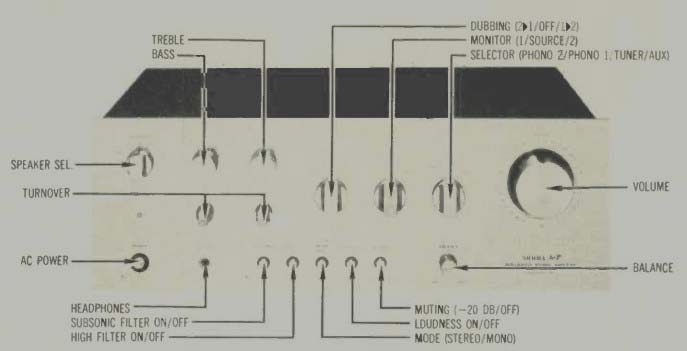
Onkyo's A-7 Integrated Amp: Virtue in Reticence
The Equipment:
Onkyo Model A-7, a stereo integrated amplifier, in metal case.
Dimensions: 17 1/2 by 6 1/4 inches (front panel), 13 1/2 inches deep plus clearance for controls and connections.
Price: $349.95.
Warranty: "limited," three years parts, two years labor.
Manufacturer: Onkyo Corp. Japan; U.S. distributor: Onkyo U.S.A. Corp. 42-07 20th Ave., Long Island City, N.Y. 11105.
Comment: If, as is generally thought, lack of personality is a commendable feature in an amplifier, the Onkyo A-7 can be said to have achieved a considerable measure of virtue.
It plays music with minimal coloration, can be put through its paces without special effort or understanding on the part of its human master, and is reasonably tolerant of vagaries in the other components with which it must be used.
Furthermore, its sections are well balanced-no one is far above or below the general quality of the whole.
The Onkyo A-7 is exceptional in that it has a 4-ohm rating (70 watts-18 1/2 dBW-per channel) as well as one for 8 ohms (65 watts/ 18 dBW per channel). Data taken at CBS Technology Center verify that the ratings are accurate with a comfortable margin of safety. At rated power, the total harmonic distortion averages only a third of its specified value (0.1%) and barely exceeds 0.06% at 20 kHz. Distortion components remain small down to low power levels and are close to the noise floor of the amp (which is itself quite low at 90 dB below the rated 18-dBW output for the high level inputs) as far down as 20 dB below full power. IM distortion is somewhat lower than specified with an 8-ohm load and somewhat higher with 4 ohms. The bandpass is a little wider than average, especially at the bass end, where a square wave is reproduced with surprisingly little tilt. The-3 dB point at the high end is beyond 70 kHz. The damping factor is adequate.
The phono equalization is exceptionally accurate and the overload point more than adequate for almost any conceivable circumstance. Signal-to-noise ratio of this section is very good at 75 dB-e full output (equivalent to 87 dB re a 10-millivolt input). The choice of circuit geometry for this stage seems felicitous, for we are unable to find any evidence of undesirable interaction with phono cartridges.
The control panel of the A-7 is distinguished by its large, open design and rather unusual layout. The controls that are used most frequently are on the upper two-thirds of the panel. The oversized volume control knob has thirty two detented positions. The four-position input selector handles two phonos, tuner, and auxiliary. It functions in conjunction with the adjacent three-position monitor switch that expands the switching capability to include two tape decks. Dubbing between the decks--in either direction--is determined by the next three-position switch and is independent of the selector position. Thus, dubbing be tween decks can take place while listening to another source. The bass and treble controls have eleven switched positions. Below each tone control is a three-position turn over switch (125-Hz/DEFEAT/400-Hz for the bass, and 2 KHz DEFEAT/8-KHZ for the treble) with actual 3-dB turn over points reasonably close to the frequencies indicated.
Two sets of loudspeakers can be handled in the conventional Ai BiA + B manner.
The less frequently used controls are clustered on the lower third of the panel. Of these, the subsonic and high cut filters are relatively ineffective, and the BALANCE has no detent to identify the equal-gain position.
Besides the normal complement of inputs on the rear panel (including a removable link between the preamp and power amp) there are three convenience outlets (one of which is switched) and a set of speaker fuses. Connection to the speakers is via color-coded binding posts that are most suitable for bare-wire connections. There are molded off-center slots on the connecting strip that guide the wire into position so that the strands wrap around the post as it is tightened.
The Onkyo A-7 is a competent all-around performer with sufficient power capability for most applications. The LOUDNESS, whose quite mild contour introduces enough bass and treble boost at low volume levels to help restore the tonal balance without overwhelming the music, is more felicitous to our ears than many. The selectable-turnover tone controls are a boon. When they are set for 125 Hz and 8 kHz it is easy to taper the extreme ends of the spectrum without altering the midband balance-and that, to many serious music lovers, is what a tone control is for.
The exceptionally clean and sharp phono preamp, one of the strong points of the A-7, is virtually overload-proof.
For its price, the A-7 comes notably close to doing what an amplifier is supposed to do--amplify and nothing else.
When alteration of the signal is called for the control section generally is willing and competent. The Onkyo A-7 re produces music-subtly and without introducing its own personality.
Onkyo A-7 Amplifier--Additional Data

-------HARMONIC DISTORTION CURVES

-------Square-wave response; INTERMODULATION
CURVES
-------------
(High Fidelity, Nov. 1977)
Also see:
Sony Model TAN-8550 power amplifier (Equip. Report, Jul. 1975)